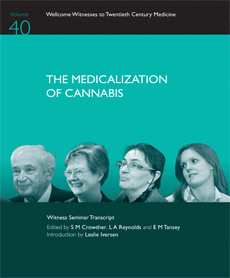Somewhere in the East of England thousands of cannabis plants are growing within a high-security secret site. Their destiny is to become a component of medical treatments for a range of conditions, and specifically for the treatment of multiple sclerosis. Medical practitioners have differing views on the likely benefits of this novel therapy: some are highly enthusiastic, whereas others remain sceptical and consider the drug to lack legitimacy in a clinical environment. Perhaps even the word “novel” is inappropriate in this setting, since cannabis has been used as a drug from the 1800s, but understanding of its potential only blossomed three decades ago when cerebral cannabinoid receptors were first identified.
Volume 40 of the “Wellcome Witnesses to Twentieth-Century Medicine” series represents a collection of transcripts of testimony provided by a diverse group of individuals – clinicians, scientists and patients – invited to contribute to a conference held in London, the topic being the medical use of cannabis over the centuries. The volume is not really a book at all, but is more of a verbatim record of what was said “on the day”, with some commentary, by way of annotation. It reads like a stenographer’s transcript of legal proceedings, in which the evidence in favour of and against the use of cannabis for medical purposes has been advanced and rebutted. But that is not to be critical of the style, rather the presentation tends to draw the reader in, as though they themselves were party to the debate at the time, albeit at the expense of some continuity of content.
It is clear that some of the speakers whose words are recorded in the volume are passionate advocates of the cannabinoids, whereas others express doubt. The early reluctance of “mainstream” pharmaceutical companies to embark on cannabis-related research because of the perceived stigma is stressed. Very reasonably, many contributors draw attention to the plethora of self-reports of benefit of cannabis in treating the symptoms of diverse conditions, with inevitable emphasis on MS. The exacting reader may find it disappointing that the proponents speaking strongly in favour of cannabis are not forced to scrutinise their statements with greater scientific ruthlessness, to ensure that their assertions can truly be backed up by an evidence base. The scientists whose thoughts are presented certainly make valiant efforts to maintain perspective. But overall we are still given too much anecdote, methinks, with one enthusiast noting that her experience of smoking cannabis didn’t just relieve the pain and ease the spasticity imposed by her MS, but also helped her to sleep and to eat. Meanwhile another MS sufferer notes simply “Cannabis has changed my life. It really has.” Quite some claims! They go largely unchallenged in the debate.
This volume will certainly be of interest to those who have coordinated research into the benefits of cannabis in neurology. However, for others, it may be rather heavy-going despite its brevity, in part because of the format. Many will find the lack of intellectual rigour in some parts disappointing. All, however, will be interested in the historical perspective offered by early sections of the book. These give insight into a potential therapeutic agent which has found favour, not just in recent years, but which in reality has a pedigree stretching back many thousands of years in the history of medical practice.
If you don’t have a special interest in this area, this is one to glance at, perhaps, if it catches your eye from a top shelf in the library.

